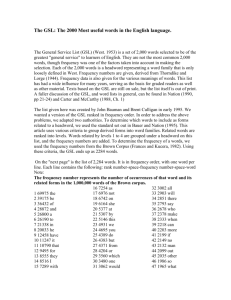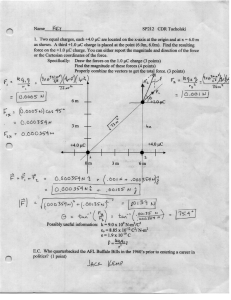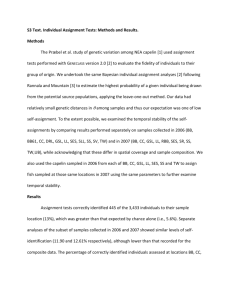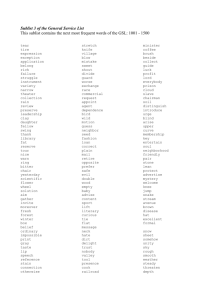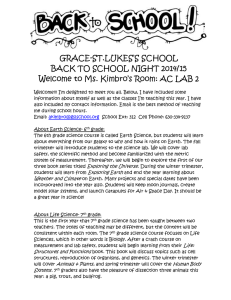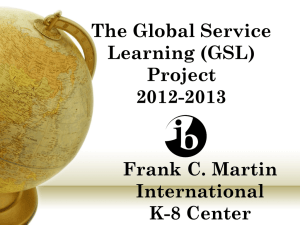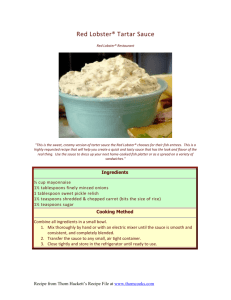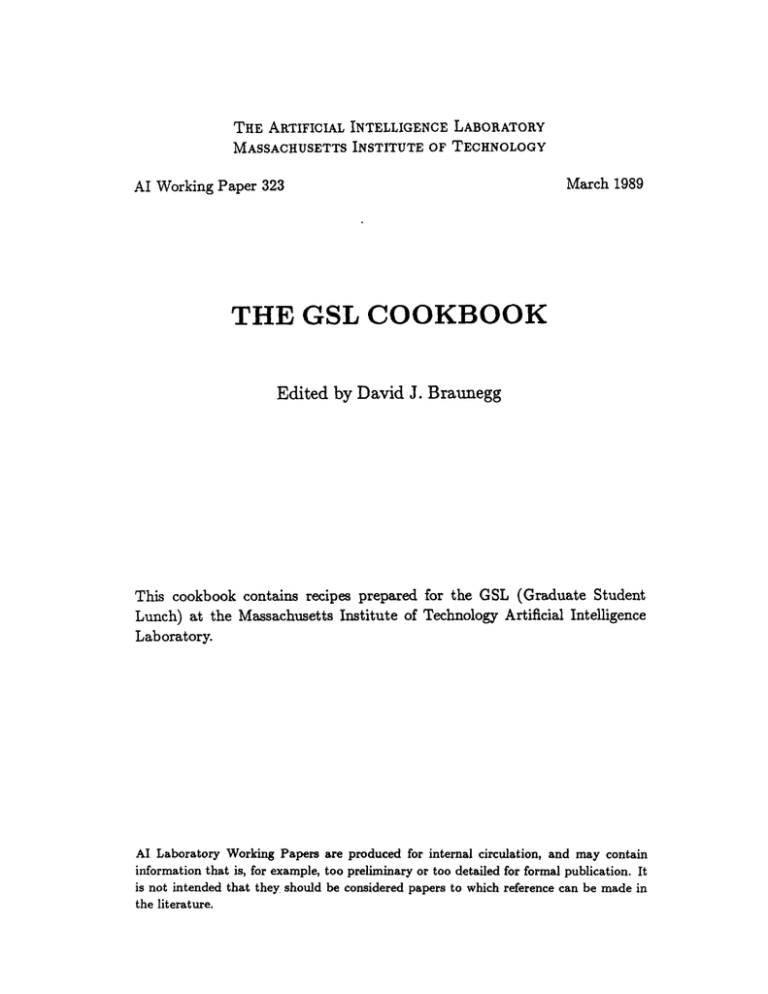
THE ARTIFICIAL INTELLIGENCE LABORATORY
MASSACHUSETTS INSTITUTE OF TECHNOLOGY
AI Working Paper 323
March 1989
THE GSL COOKBOOK
Edited by David J. Braunegg
This cookbook contains recipes prepared for the GSL (Graduate Student
Lunch) at the Massachusetts Institute of Technology Artificial Intelligence
Laboratory.
AI Laboratory Working Papers are produced for internal circulation, and may contain
information that is, for example, too preliminary or too detailed for formal publication. It
is not intended that they should be considered papers to which reference can be made in
the literature.
The GSL Cookbook
Edited by David J. Braunegg
@ 1989 by David J. Braunegg. All rights reserved.
Reproduction and/or distribution of all or part of this work for noncommercial purposes is permitted as long as the copyright and this notice are
included in any reproduction or distribution.
No claim is made for the fitness or appropriateness of the information
contained herein for any purpose whatsoever, including, but not limited to,
cooking, eating, and humor.
First Edition
Preface
This book is intended to help GSL (Graduate Student Lunch) volunteers prepare a GSL. The GSL recipes in this book have been used successfully at past
GSL. These recipes can be used directly or be simply considered guidelines
for the quantities of food needed to feed 75 hungry graduate students.
I have tried to leave the recipes in the original words of the authors.
Changes were only made for the sake of clarity and consistency.
When I have been able to attribute a GSL recipe to one person, that
person's name is listed. If more than one person hosted a GSL that did not
rely on a single recipe, all the people involved are listed.
In order to encourage the tradition of interesting GSL meals, this cookbook was compiled. The section entitled GSL Recipes contains recipes which
were actually used in past GSL's along with occasional hints for what might
have been done differently. The HELP Recipes section contains recipes originally from the Help database on OZ. Finally, the Other Lab Recipes section
contains a few favorite recipes from lab members willing to share them with
us. Additions to this book from future GSL's as well as favorite recipes of
graduate students, faculty, and staff are welcome.
This cookbook is dedicated to those proud GSL volunteers who, over the
years, have kept MIT's Computer Science graduate students well-fed (at least
for one meal out of the week). A special thanks goes to the GSL coordinators
past and present, as well as the administration officials who find the money
for this grand event.
DJB
Cambridge, Massachusetts
August 15, 1988
Acknowledgments
I would like to acknowledge Professor Patrick H. Winston, director of the MIT
Artificial Intelligence Laboratory, for his support of the Graduate Student
Lunch program over the years. Patrick Winston and the AI Lab are also
thanked for the resources used to prepare this cookbook.
I would also like to acknowledge the help and dedication of the GSL
coordinators and volunteers past, present, and to come. Without them, we
would all be a bit thinner.
Table of Contents
P reface . . . . . . . . . . . . . . . . . . . . . .
Acknowledgments
. . . . . . . . . . . . . . . . .
GSL History . . . . . . . . . . . . . . . . . . . .
GSL Recipes . . . . . . . . . . . . . . . . . . . .
Dun Dun Mein (Dun Dun Noodles) . . . . . . . . .
C hili . . . . . . . . . . . . . . . . . . . . . .
Jambalaya . . . . . . . . . . . . . . . . . . . .
Gingersnaps . . . . . . . . . . . . . . . . . . .
Tacos, Burritos, and Enchiladas
. . . . . . . . . .
Carnivorous and Vegetarian Chili
. . . . . . . . .
Chicken Soup with Matzo Balls
. . . . . . . . . .
Lamb and Barley Soup ....................
Lentil Stew
. . . . . . . . . . . . . . . . . . .
Poached Chicken Breast with Thai Peanut Sauce and
Noodles
Franks and Beans
......................
Chef's Salad . . . . . . . . . . . . . . . . . . .
Chicago Chili and Vegetable Soup
. ..............
South Indian Cuisine ......
. ....
...
..
HELP Recipes ......................
Help Banana
. . . . . . . . . . . . . . . . . .
Help Cheesecake ..
....
. ...
...
...
..
Help Peking-Ravioli
....................
Other Lab Recipes ......................
Brownies
. . . . . . . . . . . . . . . . . . . .
Georgia Ice Cream . . . . . . ..
. . . . ..
. .
Jan's Blonde Brownies
....................
Javanese Spiced Pork .....................
iii
.
.
.
.
.
.
.
.
.
.
.
.
.
.
.
.
.
.
.
.
.
.
.
.
.
.
.
.
.
.
.
.
.
. .
. .
. .
.19
. ..
. .
. .
. .
. .
. .
. .
. .
. .. i
. . ii
. .1
.
.
.
.
.
.
.
20
21
23
25
26
28
30
31
. . . . . . 32
. . . . . . 33
36
. . . . . . 37
38
. . . ..
39
... ..
41
. . . ... 42
. ..
..
43
. 44
.
47
. . . . . . 48
. . . . . . 49
50
51
GSL History
GSL History
The GSL is part of an arrangement between MIT's Artificial Intelligence
Laboratory (AI Lab) and Laboratory for Computer Science (LCS). LCS pays
for the weekly Faculty and Research Staff luncheon (Faculty Feed) and the AI
Lab in turn pays for the weekly Graduate Student Lunch (GSL). The Faculty
Feed serves as an excuse for the faculty to gather and plot evil deeds against
the grad students, such as orals, area exams, and the like. The GSL provides
the grad students with the opportunity to get together to commiserate their
sad fate and to plot revenge.
Actually, the GSL is intended to promote interaction between graduate
students in the various areas of computer science (Course VI, Area II) who
might not otherwise have any contact. Therefore, contrary to popular belief,
technical discussions are not forbidden at GSL's, but are actually encouraged.
Early on, a typical GSL consisted of simple sandwich materials, and a freefor-all would ensue immediately upon arrival of the food. Typically, a. grad
student arriving at 12:01 PM would have a tasty lunch of a hand sandwich
(a piece of bread held in the hand) and a few potato chip crumbs. After a
budget increase, sufficient food was available so that a more civilized approach
could be enforced-a food line (queue for you Anglophiles) was introduced.
Recent years saw more budget increases and the quality and quantity of food
provided at the GSL's has improved.
Table 1 contains a list of past GSL coordinators, as can best be recalled
by Walter Hamscher. [Please send me any corrections or additions. - Ed.]
A tradition of humorous GSL announcements has developed over the
years. Some of these announcements were pure whimsy, while others were
based on actual seminar announcements. Of late, it has become quite an
honor to have one's seminar parodied in a GSL announcement. Some of the
more memorable GSL announcements (and a few replies) are collected on the
following pages.
GSL History
Semester
Coordinator
F 80
S 81
F 81
S 82
F 82
S 83
F 83
S 84
F 84
S 85
F 85
S 86
F 86
S 87
F 87
S 88
F 88
S 89
Daniel Weise ?
Daniel Weise ?
Kfiren Wieckert
Ktren Wieckert
Karen Wieckert
Peter Andreae ?
Walter Hamscher
Walter Hamscher
Walter Hamscher
Walter Hamscher (hack announcements start in earnest)
Walter Hamscher
Walter Hamscher
Elisha Sacks
Elisha Sacks
Bonnie Dorr and David Braunegg
Bonnie Dorr and David Braunegg
David Braunegg
David Braunegg
Table 1. GSL coordinators over the years.
>From walter Thu Mar 1 10:00:31 1984
To: *mac(Dmc
Subject: GRADUATE STUDENT LUNCH
Cc: bboard.mail
Computer Aided Conceptual Art (CACA)
Eternally Evolving Seminar Series
presents
YOKO: A Random Haiku Generator
Interns gobble oblist hash
Cluster at operations
Hidden rep: convert!
Chip resolve to bits
Bus cycle inference engine
Exposing grey codes
We will be discussing YOKO and the
related issues of computer modeling
of artists, modeling computer artists,
computer artists' models, computer
models of artists' models of computers,
artist's cognitive models of computers,
computers' cognitive models of artists
and models, models' models of models,
GSL History
Take-grant tinker bucks
Pass oblist message package
Federal express
I
I
artists' models of computer artists,
modelling of computer artists' cognitive
models and artist's models of cognition.
Hosts: Claudia Smith and Crisse Ciro
REFRESHMENTS WILL BE SERVED
GSL History
>From walter Thu Mar 1 10:00:31 1984
To: *mac(mc
Subject: GRADUATE STUDENT LUNCH
Computer Aided Conceptual Art
Evolving Seminar Series presents
SMALLTALK-52 AND THE WHEELER SEND
Recently discovered documents reveal that J.M. Wheeler
designed the first version of Smalltalk in 1952.
It was intended to run on the University of Cambridge's
EDSAC Computer. The initial implementation, however,
required the entire 512-word memory and was deemed
infeasible. Wheeler, who is credited with the invention
of bootstrap code, subroutine calls, assemblers, linkers,
loaders, and all-night hacking, can now be properly
credited with inventing message passing, object oriented
programming, window systems, and impractical languages.
This fascinating historical discussion will be hosted
by Steve Berlin and will be preceded by Lunch.
Next week: Lady Lovelace's Encryption Algorithm
GSL History
>From walter Thu. Apr 5 18:41:57 1984
To: *maccmc
Subject: Computers and Incomprehensibility
ANNALS OF COMPUTER SCIENCE SEMINAR SERIES
Presents
LADY LOVELACE'S ENCRYPTION ALGORITHM
Wkh iluvw frpsxwhu surjudpphu zdv d qlqhwhhqwkOfhqvxuqreohzrpdq/
Odgi Dxjxvwd Dgd Oryhodfh/ gdxjkwhu ri vkh srhv Orug Elurq.
Dv d whhqdjhu/ Dxjxvwd glvsodlhg dvwrqlvklqj surzhvv lq pdwkhpdwlfv.
Zkhq vkh zdv hljkwhhq dxjxvwd iluvw vdz Fkduohv Edeedjh*v dqdolwlfdo
hqjlqh/ d fdofxodwlqj pdfklqh wkdw zdv wkh iruhuxqqhu ri wkh prghuq
frpsxwhu. Lq hljkwhhq iruwlOzr/ vkh wudqvodwhg d sdshu rq wkh
hqjlqh iurp Iuhqfk wr Hqjolvk/ dgglqj khu rzq yroxplqrxv qrwhv. Lq
vxevhtxhqw zulwlqjv vkh ghvfulehg wkh frqfhswv.
GSL History
Date: Thu 26 Apr 84 17:32:46-EST
From: MONTALVOSubject: Video tape from Brown University
To: *bboardcc: MONTALVO
I can say something about the video tape that STRAZ is showing on Mon.
from Brown University. I went to the presentation given here by Andy
Van Dam. He is a well known figure in computer graphics and he
together with Jim Foley from GW Univ. have written the only (correct
me if I'm wrong) book on interactive computer graphics and one of the
very few textbooks on computer graphics. The talk was on the
illustration of hard, computer science concepts using computer
graphics, specifically animation graphics. It was also on how they
actually used this system to teach comp. sci. at Brown. I highly
recommend the talk.
If you want to know more you can ask me.
Fanya
>From root Thu Apr 26 19:40:03 1984
ReSent-date: Thu 26 Apr 84 19:37:44-EST
ReSent-From: Bernard M. Gunther <SE.BMGMIT-EECSOMIT-MC.ARPA>
ReSent-To: *bboardQMIT-MC
OVERCROWDING: THE BLACK HOLE OF COURSE VI
Forum for all Course VI students including newly declared
froshlings.
Featuring a panel of Course VI faculty and administrators.
Date: May 3rd, 1984
Time: 7:30 PM
Place: 34-101
Bring flames, beefs, tar, and feathers: AUDIENCE DISCUSSION WILL FOLLOW.
GSL History
Date: 26 Apr 1984 20:25:24-EST
From: walter at mit-htvax
To: montalvotoz
Cc: *macomc
Fanya,
I can say something about the GSL that TAR and ELISHA
are doing on Friday (see message below). I went to a
GSL last week. Tom and Elisha are well known figures
in LCS and are are doing the only (correct me if I'm
wrong) GSL this week. I highly recommend the food.
If you want to know more you can copy HTVAX:/projects/gsl.txt
Walter
From walteremit-htvax Thu Apr 19 12:40:02 1984
Date: 25 Apr 1984 12:34:36-EST
From: walter at mit-htvax
To: *maccmc
Subject: GSL
OVEREATING: THE BLACK HOLE OF GRADUATE COURSE VI
Forum for all Course VI Area II graduate students.
Featuring a flock of vultures in a feeding frenzy:
You have to be there to see it!
Date: May 27th, 1984
Time: 12:00 Noon
Place: AI Lab Playroom
Tom Russ and Elisha Sacks will moderate.
GSL History
>From walter Thu Mar 22 13:31:25 1984
To: *maclmc
Subject: MIT Playroom Eating Club workshop
The MIT Playroom Eating Club presents
SCARFING for beginners
and a professional workshop in
GLUTTONY
Workshop
Beginning
Professional
Time
12:01-12:10
11:55-12:01
Prerequisite
No previous experience (No food either).
Beginning workshop or familiarity w/ basic hogging
Join us in the AI Lab Playroom (the big room 3 floors directly
above the LCS Student Lounge) at 12 noon on Friday, March 23rd
for ten minutes of intense pigging out. See you there!
This week's trough will be filled by Bonnie Dorr and Dave Braunegg.
If you want to volunteer to provide food for this weekly event,
please get in touch with Walter in NE43-825 (office) or NE43-825 (home).
GSL History
Date: Thu, 14 Feb 85 11:23:57 est
From: Walter Hamscher <hamscherQmit-htvax>
To: *macImc
Subject: Graduate Student Lunch
TIME: 12 Noon
DATE: Friday
PLACE: 8th Floor Playroom
HOSTS: Mark Tuttle and Sathya Narayanan
REFRESHMENTS: t
PLAUSIBLE HAIRSTYLE GENERATION:
THE FURTHER ADVENTURES OF EURISKO, PART I
Blackstone Le Mot
As AI programs have been reported more widely in the popular
media, they have been called upon to perform tasks that have
heretofore gone unnoticed by AI researchers. Proper hair care
is one of these tasks. In this talk I will discuss the application
of EURISKO to developing healthy hair and attractive styling.
Remarkably enough, the program itself has modified itself
to represent characteristics of the domain, by developing
hair in its control structure and a significant bald spot
in its documentation. But it looooks maaaahvelous!
GSL History
Date: Thu, 21 Feb 85 19:51:37 est
From: Walter Hamscher <hamscher~mit-htvax>
To: *maccmc
Subject: EURISKO Seminar, Continued
TIME: 12 Noon
DATE: Friday
PLACE: 8th Floor Playroom
HOSTS: Michael Caine, Neil Singer, and Kenneth Pasch.
REFRESHMENTS: t
PLAUSIBLE POSITION GENERATION:
THE FURTHER ADVENTURES OF EURISKO, PART II
Blackstone Le Mot
This talk was to be the second in a series describing the application
of EURISKO, a discovery program, to non-traditional domains. In this
case the domain was position generation, in which the program is given
some knowledge of geometry, anatomy, and the first 37 pages of the
Kama Sutra. The talk is canceled, however, because the slides have not
yet been cleared with Dean McBay and the Ad Hoc Committee. Hence we
instead skip to the third and final talk in this series:
TARGET SELECTION:
THE LAST ADVENTURE OF EURISKO, PART III
Traditional strategic thinking, i.e. from Clausewitz to the present day,
emphasises the need to bring maximum destructive force to bear on the
enemy's armed forces and industrial centers to ensure a swift end to
hostilities. Present day weapons systems have been characterized as
"eggshells armed with hammers," suggesting that in the event of
hostilities, targets must be swiftly chosen, in time-frames requiring
automated response, to avoid the loss of precious megatonnage. In this
experiment we used EURISKO to choose targets in simulated nuclear exchanges,
with extremely exciting results.
GSL History
Date: 22 February 1985 08:32-EST
From: Benjamin Kuipers <BENQMIT-MC>
Subject: EURISKO Seminar, Continued
To: hamscher@MIT-HTVAX
In connection with the Last Adventures of EURISKO, I once observed
to Lenat that it wouldn't actually be a major step for Eurisko to
simulate something like the final scene of the movie "War Games".
It would be learning properties of game trees by experimenting with
simulations of individual games. One property inferred might be
the "positive-sum", "zero-sum", "negative-sum" character of games.
If you had programmed it to consider game-playing as a selectable
activity among several, contributing to an overall utility function,
then discovering that a game was not only negative-sum, but wouldn't
even let an individual break even, could allow Eurisko to formulate
a rule against playing that game. So the movie wasn't that far off
base, eh? There might be one or two remaining technical problems,
of course ...
Ben
GSL History
Date: I Mar 1985 0913-PST
From: <named withheld to protect the gullible>
Subject: EURISKO SEMINAR
To: hamscherQMIT-HTVAX
Walter Hamscher
Hello,
I saw a notice by you in Ken Laws AI Digest about a EURISKO seminar.
Are there any notes on the seminars? I assume I may never see the
interesting work related to the Kama Sutra positions,
but hopefully the first and third seminars might be available.
Is EURISKO available to try experiments?
THANKS,
<name>
<address>
<telephone number>
<net address>
To: <name withheld to protect the gullible>
Subject: Re: EURISKO SEMINAR
Umm, well... I'm going to treat this as a serious request,
though I know there's a possibility you're just hacking me...
Those messages are joke announcements for Graduate Student
Lunch, a weekly institution in the MIT AI Lab/Lab for
Computer Science, and there is no (CACA) seminar series, nor
is there a working version of Eurisko around here. I only
send the announcements to '*macQmc', which is a
building-local mailing list, but somebody (Ken Laws?) always
seems to forward the things all across the Arpanet. Causing
some confusion, I gather.
If you're truly interested in using Eurisko to generate
GSL History
hairstyles or select targets, get in touch with Doug Lenat
himself. I believe that's DLenatQXEROX.ARPA.
Sorry...
Walter Hamscher
Date: 2 Mar 1985 1050-PST
From: <name withheld to protect the gullible>
Subject: Re: EURISKO SEMINAR
To: hamscherQMIT-HTVAX
In response to your message sent
Fri, 1 Mar 85 12:48:32 est
Thanks for the reply; my request was HOPE not Hack.
I did pick up the notice via Ken Laws
AI messages.
So far I have not had any luck in finding a copy of EURISKO.
I will try Doug Lenat again. I thought he was at MCC.
Thanks again,
<name>
GSL History
Date: Thu, 16 May 85 18:01:50 edt
From: Walter Hamscher <hamscheremit-htvax>
To: *macemc
Subject: REVOLTING SEMINAR FRIDAY AT NOON
DATE:
TIME:
PLACE:
HOST:
Friday, 17 May
12 NOON
8th FLOOR PLAYROOM
Michael Kashket
QUALITATIVE CALCULATORS IN CLINICAL DECISION MAKING
(-:
Tex Tuftsman
The classical approach to decision analysis in medicine has
been based on constructing decision trees, giving numerical
weights to outcomes, and banging away at the keys of an
ordinary 16-key calculator to choose between appropriate
therapies. Some of the weaknesses in this approach can be
avoided by using a QUALITATIVE CALCULATOR (c) from Ronco.
Envision yourself with a QUALITATIVE CALCLUATOR (c) -- A
QUALITATIVE CALCULATOR especially designed for Naive
Physicists. Comes with [+], [E-, and (0] keys, plus a Clear
key and a DeClear key. Was $20.99, marked down to [+]. But
wait -- There's more! Qual before [0) tonight and get a free
State Map for your locality. Operators are standing by!
Don't miss this landmark value!
REFRESHMENTS WILL BE SERVED
+++++++++++++++++++++++++++++++++++++++++++........
..........
The following (serious) announcement comes courtesy of Prof.
Randy Davis:
In a time when near-term applications of AI have received
considerable attention and reward, it is encouraging to
announce the first award of the Philip A. Cooper Fellowship,
designed to recognize important progress on fundamental
GSL History
research in AI. The Fellowship has been made available
through the generosity of Philip A. Cooper (SM '84), as a
result of his feeling that commercial enterprises have a
responsibility to support basic research, the exploration of
important advances on fundamental problems, ideas whose
significance lies in the insight they provide rather than
potential near-term application.
The Award this year is being made jointly to ...
Come to the GSL this week and find out, when the presentation
is made.
+++++++++++++++++++++++..
. ++++++++++++++++++++++.+++
.
.
..
.
The following (also serious) announcement comes from me:
Many, many thanks to everyone who helped with GSL this year.
Thanks to Patrick Winston for footing the bill and Spaulding
& Slye for cleaning up afterwards. Thanks to Bonnie Dorr and
Dave Braunegg for coaxing volunteers and filling in during
emergencies. Thanks to ADSQoz, BECKERLE(xx, BGQxx, CHIENexx,
CRISSE(oz, DMSQoz, DTCloz, ELANQmc, ELISHAQmc, GASPOmc,
GERSTENQoz, HJHOht, HLV~oz, KAPeoz, KASHQoz, KTexx,
LUCASSENtxx, MARTYCoz, MEC~oz, MHS4mc, MICHAELG~oz, MPWQmc,
NSINGQoz, RAGQmc, REIDQoz, SANDIWAYeoz, STAMOSQxx, SUNDAR~oz,
TAR(mc, TUTTLEixx, WELDQoz, WILLIAMSQoz, and anybody else I've
unintentionally forgotten, for doing all the good work.
Thanks to you, it's edible!
The next GSL will be on Friday, September 13th.
See ya there!
Date: Fri, 17 May 85 09:16:17 EST
From: Benjamin Kuipers <BENOMIT-MC>
Subject: QUALITATIVE CALCULATOR (c)
To: hamscherQMIT-HTVAX
Cc: BENQMIT-MC
Please send me a new Qualitative Calculator (c) by return mail!
GSL History
I've been waiting for years for it to go on sale. I use my old
one all the time, but it broke (the DeClear key sticks), and I
haven't known how to replace it.
I enclose the advertised price, plus shipping and handling:
[+] + [+] = [+1.
I wait eagerly for my new Qualitative Calculator.
Yours,
T.T.
Date: Sun, 19 May 85 08:06 PDT
From: dekleer.paQXerox.ARPA
Subject: REVOLTING SEMINAR FRIDAY AT NOON
To: hamscherYmit-htvax0mit-mc.ARPA
re.
QUALITATIVE CALCULATORS IN CLINICAL DECISION MAKING
It looks like you are spending all your time writing these
witty abstracts. When are you going to do your PhD?
That last message, by the way, was the one that
finally got me out of the GSL business.
GSL Recipes
Dun Dun Mein (Dun Dun Noodles)
Ken Traub and assorted others
GSL on numerous occasions
(From The Chinese Restaurant Cookbook, by Barbara Myers)
NOODLES
1
lb Fresh or Frozen Noodles (or 3 ounces dried)
tsp Sesame Oil
Cook the noodles in unsalted boiling water until just tender. Drain and
rinse with cold water until cool, then dribble the sesame oil over them to keep
them from sticking together.
SEASONING SAUCE
1
1
2
1
11
1
1
1
Tbs Sesame Paste
Tbs Chicken Broth
tsp Peanut Oil
tsp Chili Oil
tsp Dark Soy Sauce
tsp Vinegar
tsp Sugar
clove Garlic, Finely Chopped
Combine seasoning sauce ingredients in the order given. The sauce is
easier to prepare if the broth is hot, but the sauce should be chilled to room
temperature before serving.
1
Scallion (green part)
Cut scallion into ¼inch rings. Place the sauce in the bottom of a bowl,
cover with the noodles, and top with scallions. Serve at room temperature or
colder. Yield: one serving.
(The original recipe for the sauce also called for MSG and Szechuan
Preserved Vegetable. I think the former unnecessary, and the latter not worth
the trouble. Peanut butter may be substituted for the sesame paste: the result
is somewhat mellower, but not appreciably different in taste. Middle eastern
sesame paste (Tahini) does not make an acceptable substitute for Chinese
Sesame Paste.)
Chili
Margaret Fleck
GSL 10/23/87
This amount of materials made about 25 quarts of chili con carne plus about
6 quarts of vegetarian chili. This was almost exactly right to feed a GSL
(with more than the usual 60 person turnout) with only small amounts left
over. Remember that the total volume of your pots should be somewhat more
than this, perhaps 40 quarts, so you don't end up filling the pots to the brims
and/or having to put overflow into additional pots.
7
12
3
4
10
6
3
8
;24
1
2
2
2-4
small
(1 lb?) bags dried chili beans and/or kidney beans
lbs meat
28oz cans whole peeled tomatoes
28oz cans crushed tomatoes
12oz cans tomato paste (Do NOT get less than this much.
You might get a couple more cans to be on the safe side.)
really big onions
bulbs garlic
green peppers
fresh chili peppers (the mild ones, not jalapefios; this amount
could be increased)
container cayenne powder
big (1¼ oz) containers oregano (of which 1i were used)
containers cumin (completely used up; slightly more could
have been used)
cups flour
amount of corn oil (for cooking onions for veggie pot)
We took three hours to cook the chili, of which it was an hour before
the beans were added and could start to cook. This was just sufficient to get
them cooked sufficiently: slightly more time might be desirable.
Soak the beans overnight in massive amounts of water. Before soaking,
pick them over for rocks and suchlike and rinse them. [Make sure you soak
the beans long enough. We had a marginal GSL chili (not this one) where
the beans had not soaked long enough. The beans were still hard at 5 that
afternoon. - Ed.]
Slice the onions, relatively coarsely.
Chili
Brown the meat, then lightly cook the onions in the meat (don't need to
brown them). For the veggie pot, cook the onions in a little corn oil.
Add the beans together with enough water to just cover them. You might
use some of the water they were soaking in. Bring the water to a boil.
=* Try to keep all pots boiling, but not violently, from now on. As the
mixture is thickened, this may require re-adjustment of the temperature. Stir
frequently, both to mix and to reduce the inevitable amount that burns onto
the bottom of the pot.
Chop chili peppers into small slivers and add. It is wise to make one
pot hotter than the other for variety. Also go easy on the hot peppers in the
vegetarian pot, as the meat fat takes up some of the hot oil in the other ones.
Add the oregano.
Chop/crush the garlic as fine as possible and add it.
= The oregano, the garlic, and the chili peppers should be added early,
as they need to cook in.
The main thing you are doing now is waiting while the beans cook. During this time, (1) cut up the green peppers coarsely and add them, (2) add
the cumin, and (3) add all the tomato ingredients.
About 30 minutes before serving, mix up flour and water into a thick
slurry and stir it into the chili. Do this in batches of at most 1/2 cup of flour
at a time. The point of this is to thicken the chili and it is optional.
Add cayenne pepper to adjust the hotness. Adjust cumin or oregano if
necessary.
Serve with grated cheese (we used perhaps 10 pounds?), saltine crackers,
and corn chips.
Jambalaya
Tom Cormen
GSL 11/13/87
Jambalaya is a kitchen sink type of dish, so all amounts are very vague. You
just put in as much of each amount as you think you can stand. What's
important is the procedure.
Before cooking the jambo, you should prepare the following ingredients:
lots of chopped onion
lots of minced garlic
chopped scallions
chopped green peppers
chopped red peppers and/or pimientos
chopped jalapefios
olives
chickens, boiled then shredded or still in pieces
pork or ham, cooked and cubed
sausage, fried and sliced
shrimp, which is easier to eat if already shelled
live raw mussels and/or clams
Now you're ready to cook the jambo. Get the biggest pot you can find.
A thick bottom helps avoid burning, although burning on the bottom helps
add a smoky flavor that some people seem to like.
Put cooking oil in the bottom of the pot and turn the heat to med-hi.
Add the onion, garlic, scallions, peppers, pimientos, jalapefios, and olives,
then saute for a few minutes. Add the remaining ingredients from above.
Now you're ready to add and cook the rice. Use white rice, which means
you want a ratio of 2 liquids to 1 rice. Add rice and liquid, say 1 cup of rice
and 2 cups of liquid at a time, until the pot is full enough that there's plenty
of food, but not so full that the jambo will boil over once it's brought to a
boil. For the first 2-4 cups of liquid, use canned crushed tomatoes. For the
remainder, use water. Now bring it to a boil, either stirring to avoid burning
or not stirring to localize burning on the bottom. If you stir and it still burns,
you'll spread the burned, smoky flavor throughout. Again, a thick-bottomed
pot is recommended. Once it boils, reduce the heat to low, stirring as the
Jambalaya
rice cooks. Add black pepper and tabasco sauce as it cooks. Once the rice is
cooked, the jambo is done.
Note: Make sure that the rice boils before you reduce the heat. I once made
jambo with the pot so full that I was afraid to let the rice boil for fear
of the ensuing mayhem. The only mayhem that resulted was that the
jambo never cooked, and for weeks and months afterward, disappointed
party guests asked me if the jambalaya was ready yet.
Gingersnaps
Laura Bagnall
GSL 12/87
Makes 3 dozen
1
1
1
cup vegetable oil
cup sugar
egg
2
2
2
cup molasses
cups flour
tsp baking soda
Tbs ginger
tsp cinnamon
Stsp salt
Oven temperature 375 degrees
Preheat oven. In a bowl combine oil, sugar, and egg. Mixing well, add
molasses and stir again. Add dry ingredients. Mold dough into small (lin
diam.) balls and then roll them around on a plate of sugar. Flatten them
slightly and arrange 2 inches apart on an ungreased cookie sheet. Bake for 10
minutes. Do not overcook.
Note: The original recipe called for 1 tablespoon of ginger, but I double the
amount because I REALLY like ginger. Also, I usually use one tablespoon each of powdered ginger and finely chopped fresh ginger root. If
you do this, make sure it's very finely chopped.
Tacos, Burritos, and Enchiladas
Maja Mataric, Nomi Harris, Mark Hansen, and Cliff Stein
GSL 2/5/88
There was really no recipe, just a bunch of taco ingredients: tomatoes, lettuce, shredded cheese, taco sauce, onions, etc. We made taco-seasoned meat
(ground beef) as well as some refried beans. If you need exact recipes for
the meat and beans, talk to Cliff Stein [see below - Ed.], but it was mostly
throw-the-stuff-in-the-pot-and-taste-it-periodically-style of cooking. Finally,
we bought taco shells, tortillas, and ice cream.
[From Cliff Stein] I can give you a little more detail on the refried beans.
APPROXIMATE RECIPE:
8 lb beans (pinto, red kidney, white kidney)
4 cloves garlic
4 onions
tomato sauce (Mexican, not Italian)
salsa
corn meal
jalapefio peppers
SPICES:
cumin
red pepper
black pepper
paprika
chili powder
oregano
Saute the garlic and onions (chopped) in oil for about 5 minutes. Add the
beans, tomato sauce, salsa, and jalapeiio peppers. it should be the consistency
of thick soup. Add spices to taste, use lots of cumin. Bring to boil and lower
flame. Let simmer for about 30 minutes, stirring occasionally, and adding
spice as necessary. Towards the end, add corn meal to thicken. You will
probably need about a half cup. Just add it in and stir, add more if it is not
thick enough.
Tacos, Burritos, and Enchiladas
The meat can be done similarly. First pan fry the meat and drain the
fat. Add package(s) of taco spices and/or the spices above and then follow
the recipe above sans beans.
Serve with taco shells, lettuce, tomatoes, onions, and cheddar cheese.
NOTES:
Most canned refried beans found in stores contain lard. These are NOT
vegetarian.
We should have made more beans.
If you use fresh beans (we used canned) soak and cook them according
to directions. (They need to soak for a long time, so plan in advance.)
Carnivorous and Vegetarian Chili
James Park, Javed Aslam, Rob Schapire, and Jon Riecke
GSL 2/12/88
(1) CARNIVOROUS CHILI (makes about 30 quarts)
15
5
15
15
pounds ground beef (you could probably get by with less)
pounds ground pork
cans kidney beans (1 can = 16 oz.)
cans whole tomatoes
6
11
cans corn
bags onions
1½ bulbs garlic
1
green pepper
chili powder
cumin
cayenne pepper
tabasco sauce
jalapefio peppers
Brown the meat with the onions and garlic, toss everything else in, and
simmer until done.
(2) VEGETARIAN CHILI (makes about 10 quarts)
(adapted from the recipe in the Moosewood Cookbook by Mollie Katzen)
2 cups raw bulgar wheat
5 cans kidney beans
5 cans whole tomatoes
2 cans corn
½ bag onions
Sbulb garlic
1 celery
1 green pepper
the same spices as in other recipe
Carnivorous and Vegetarian Chili
Cook the bulgar, saut6 the onions and garlic, add everything else, and
simmer until done.
We made up both batches of chili the night before (it seems to taste
better if you age it a little).
We served the chili with about 15 quarts of rice, plus tortilla chips and
salsa, with soda and fruit juices (roughly 15 liters) to drink and ice cream
sandwiches for dessert.
Since only about 50-60 people showed up (there was a snowstorm that
day), we had leftovers. The amount probably would have been just about
right for a more normal 80-person GSL.
We spent just about all of our budget of $145.
Chicken Soup with Matzo Balls
David Jacobs
GSL 2/19/88
Recipe for chicken soup with Matzo balls.
MATZO BALLS
To make the matzo balls, buy a package of Manischevitz matzo balls and
follow the directions. Add the prepared balls to the soup when it is almost
done.
CHICKEN SOUP
Boil three chickens in about 18 cups of water for 1 hour, with a bunch of
dill, two bay leaves, and liberal amounts of salt and pepper. You will probably
need to split the soup up into at least two pots.
Remove the chicken and bay leaves. Let the chicken cool, then remove
the meat from the skin and bones, and return it to the soup. Add assorted
vegetables. For example, you might add 1 pound of carrots, two stalks of broccoli, six stalks of celery, five onions, three turnips, and 1/2 lb of mushrooms.
Simmer for about 20 minutes, add the matzo balls, then heat up.
This recipe will take at least two and a half hours, and will feed about
20.
SHORTBREAD
This is good for feeding many people because it is easy to make in large
quantities. Mix 12 cups flour, 8 cups sugar, and 4 cups butter. It is best to do
this in at least two batches, or it will be hard to mix thoroughly. Spread the
mixture on the bottom of a cookie sheet, reserving about 1/4 of the mixture.
Then spread jam across the dough, and sprinkle the remainder of the dough
over the jam. Bake in a preheated oven at 425 degrees for about 25 minutes.
It shouldn't be too soft when you remove it. Cool, then cut into squares. This
makes about 120 squares of shortbread.
Lamb and Barley Soup
Laura Bagnall
GSL 2/19/88
2 (5)
1 (21)
1 (21)
2 (5)
lamb shanks
cup pearl barley
cup green split peas
onions, chopped
2 (5)
1 (3)
31 (9)
cloves garlic, peeled and crushed
green pepper, cored, seeded & chopped fine
qts water or vegetable broth
1 (21)
Tbs salt
S()
tsp pepper
Put all ingredients into a soup pot. Cover, bring to a boil, then simmer gently
for 2 hours. Cut meat from lamb shanks and return meat to kettle. Adjust
seasonings to taste. Serve with crusty bread.
Notes: I am giving the recipe in the original quantities with the quantities
that I used in parentheses. I made 2-1/2 times the original amount. This filled
about two-thirds of a 16-quart pot, and with two other soups there was a lot
left over. With two other soups, I would double the recipe and probably fit
it in a 10-quart pot. With one other soup, stick with 2-1/2 or 3 times the
recipe, and if it was the only soup quadruple the recipe and use 2 or 3 pots. I
also allowed somewhat more than 2 hours for simmering. Coming in at 9am
and putting the peas, barley and water on the burners immediately while
chopping the onions, etc., resulted in the soup being ready by noon. It takes
a LONG time to get that much water to boil.
Lamb shanks are the part of a lamb from the knee to the ankle. Because
they're mostly bone, they're only good for soup and are very inexpensive.
However, they can be hard to find at the neighborhood supermarket. I suggest
getting them at Savenor's, a small market/butcher shop near the corner of
Beacon St. and Kirkland St. They sell every kind of meat that you can possibly
imagine. However, you might want to call up a few days ahead of time to make
sure that they'll have it when you come in.
This is a CHEAP recipe. I spent $11 on the lamb and $4 for everything
else.
Lentil Stew
Michael Brent
GSL 2/19/88
Honestly, there is no recipe for the lentil stew. But here is how I'll make it
the next time I try. (I can't speak for last time, since I may have forgotten
some ingredients since then or added new ones.)
Gather lots 'o roots - sweet potatoes, potatoes, onions, carrots, garlic,
and so on. Cut them into bite size chunks, say 2-3 cm 3 . The details don't
matter, since everything will fall apart in the stew. Use 250-500ml lentils in
a 3-4 litre pot filled about half way with water. Cook them until you can
gnaw through them without breaking your teeth, but not until you actually
enjoy doing so. Then dump in everything else and cook until it's nice and
mooshy. Add water as needed to prevent the stew from solidifying. When
there is nothing hard left, through in a half stick of butter. I'm a garlic fan,
so I recommend 3-4 large cloves.
While cooking, season with copious dashes of black pepper, cumin, maybe
a little basil or fresh parsley, and anything else that smells interesting. Serve
with plain yogurt or parmesan cheese, heavy, dark bread, and dark beer. Follow with fresh, crisp salad or fruit to clean the palate. Serves 7-9 battalions.
PS: You can add 50-100ml tomato paste to the water to form a base.
Poached Chicken Breast with Thai Peanut
Sauce and Noodles
Cindy Phillips
GSL 3/4/88
We used 12 times this recipe. This is the "real" recipe. We, of course did not
use as much chicken or garnishes. I'll explain below what we really did.
POACHED CHICKEN BREAST WITH THAI PEANUT SAUCE AND NOODLES:
cup crunchy peanut butter*
f
% cup coconut milk
2 Tbs soy sauce
cup freshly squeezed lemon juice
Tbs brown sugar
cloves garlic, pressed or minced
2
4
Salt
Cayenne pepper
cup chicken broth or stock
cup whipping cream
1 pound mein (Chinese noodle) or other thin pasta
2 Tbs peanut oil
6-8 scallions, thinly sliced
3 whole chicken breasts, skinned, boned, halved, and poached**
1 pound snow peas, trimmed, cut into very thin julienne, blanched
until crisp-tender, then cooled in ice water and drained**
chopped unsalted dry-roasted peanuts (garnish)**
lightly toasted sesame seeds (garnish)**
1. Combine peanut butter, coconut milk, soy sauce, lemon juice, brown sugar,
garlic, and salt and pepper to taste in a small saucepan over low heat.
Stirring constantly, cook until smooth and thickened. Place this mixture
in a blender or food processor and puree briefly. Add chicken broth and
*The peanut butter should not be the standard commercial kind with added sugar
and salt. Bread and Circus sells peanut butter in bulk. You just grind as many
peanuts as you want.
**Not used, or quantity modified.
Poached Chicken Breast with Thai Peanut Sauce and Noodles
cream; blend until smooth. Pour into a bowl, cover, and set aside. (This
mixture can be made several hours ahead and refrigerated).
2. Cook noodles in 4 quarts boiling water until very al dente. Drain and rinse
in cold water, then drain again. Place in a large bowl, toss with peanut
oil, and cool to room temperature, occasionally stirring the pasta to coat
thoroughly.
3. Just before serving, place pasta on individual plates. Spoon peanut sauce
over the pasta and sprinkle with scallions. Slice poached chicken breast
halves on the diagonal and reassemble one breast on top of each pasta
serving. Surround pasta with snow peas to resemble a nest. Sprinkle pasta
with peanuts and sesame seeds. You can garnish with coriander sprigs.
Serves 6 as a main course.
Note 1: We didn't use any salt, because the soy sauce is salty.
Note 2: "Thickened" does not mean "thick." You'll notice the change in
consistency.
Note 3: To make your own coconut milk, grate fresh coconut into a bowl and
cover with boiling water. Let stand for 30 minutes before straining
through cheesecloth; squeeze cloth to extract all the milk. (For GSL,
you will NOT want to do that). You can get canned coconut milk at
an indian food store (also at Yoshinoya on Prospect St., Cambridge
near Central Square). You can make a reasonable substitute by
dissolving 1/3 cup of canned cream of coconut (e.g., get at Stop and
Shop) in 5/4 cups hot water.
Note 4: To toast sesame seeds, place them in a small heavy frying pan over
moderate heat. Stir until seeds are golden. Remove from the heat
and pour onto a plate to cool.
Note 5: For the GSL that we did, we did not use snow peas or use the peanuts
or sesame seed garnish (we only used the scallions). In particular
the snow peas are expensive and a lot of work, although they would
have been nice. Also, we used 30 pounds of unboned chicken breasts.
We boned, skinned, and poached them, then cut them up and mixed
them directly into the noodles.
Note 6: Quantity: We made 6 recipes of hot sauce and 6 of mild. Since each
recipe makes a little more than a. gallon, we stored them into gallon
(or 2 x half-gallon) containers and mixed the rest together to make
a medium hot. We found that most people preferred hot (about 2/3
the requests) or medium (only 6 asked for mild). We actually made
the mild a bit spicy too. Remember the noodles will absorb a lot of
heat, so don't be afraid to add a lot of pepper. We had plenty of
sauce, but could have used more noodles and chicken. (Note: We
Poached Chicken Breast with Thai Peanut Sauce and Noodles
Note 7:
Note 8:
Note 9:
Note 10:
Note 11:
had some noodles without chicken for the vegetarians and only a
handful of people wanted it that way.) The weather was bad so we
had a slightly smaller turnout than normal. About 2/3 of the people
got seconds, but not as many people got seconds as wanted them.
Materials: you can get coconut milk at the Indian food store on
the street between Magazine St. and River St. in Cambridge, also
at Yoshinoya on Prospect St. We got the noodles at Yoshinoya also
because no one had a car. They are VERY expensive at Yoshinoya
and I really recommend driving somewhere to get them if you can.
Lo mein is a good style of noodle. We actually used ramen noodles.
Serving: We served the bowls of noodles (premixed with meat) and
then poured the sauce over. It makes for a more even mix (otherwise
the sauce can separate some). We had extra hot peppers to go with
the scallions and a number of people wanted them.
Beverages: We got 7 gallons of soda and 3 gallons of juice. After
lunch all the juice was gone but a good amount of soda was left.
Maybe a more even mix of soda/juice is better.
Preparation: We made the sauce the night before (I did it at home
because the kitchens here are not that well equipped). We also
started the boning of the chicken the night before. On the morning
of GSL, we cooked the noodles, cooked the chicken, and chopped
the scallions. We started at 9am and just finished at noon. It takes
about 20-30 minutes to poach the chicken. Although the noodles
cook fast, it takes over half an hour to get the big pots of water
boiling and we had to replace the water between each batch (too
hard to save).
You can substitute some kind of vegetable stock for the chicken broth
if you want something very vegetarian. The quantity is so miniscule,
however, that I'm not sure it's worth it.
Franks and Beans
Neil Singer, Ken Pasch, and Al Ward
GSL 3/11/88
This is what we should have bought (it is close to what we did buy):
DRINKS: (all soda)
6
3
4
two liter bottles Coke
two liter bottles orange soda
two liter bottles Sprite
FOOD:
170-180
3
4
4
2
1
Hot Dogs
Gallons Baked Beans
bags chips
cans sauerkraut
48oz jars pickles
32oz jar pickles
SALAD:
4
2
3
5
heads lettuce
lbs red pepper
bags carrots
jars dressing
Chef's Salad
Steven Eppinger, Karl Ulrich, Andy Christian, Mike Caine
GSL 3/18/88
Yes, our plan is still on the whiteboard right in front of me. Here are the
quantities, adjusted for leftovers and shortages.
CHEF SALAD for 70:
12
20
2
3
2
4
1
1
1
5
5
3
4
13
1
15
1
5
3
2
1
heads lettuce
tomatoes
lbs peppers
lbs cukes
lbs carrots
lbs broccoli
lb alfalfa sprouts
lb radishes
lb red onions
lbs turkey breast
lbs ham
lbs swiss cheese
lbs cheddar cheese
loaves french bread
box croutons
bottles dressings
lb margarine (tub)
half-gallons apple juice
half-gallons Coke Classic
half-gallons Sprite
half-gallons Diet Coke
Don't forget cutting boards, knives, peelers, bowls, and serving utensils.
Chicago Chili and Vegetable Soup
Dave Feldmeier, Eman Hashem, Thu Nguyen, Tim Shepard,
and Lixia Zhang
GSL 4/22/88
Lunch consisted of:
4
3
6
10
1
5
5
7
gallons chili from Andy's Chili Cart (@ $14/gallon)
(This ran out, but I think everyone got at least a first serving.)
gallons vegetable soup from Andy's Chili Cart (@ $9/gallon)
(This also ran out, but everyone seemed to have enough chili and
soup.)
lbs spaghetti (to sit under chili)
(This ran out before the chili-maybe another pound or two.)
loaves bread from the Star Market bakery
(We had half a loaf left-you have to slice it yourself, but it's worth
it.)
lb butter
(This was OK-probably 1L pounds would have been better.)
gal juice
2-liter soda
(Not much left of these either.)
12oz boxes cookies
(A box or two of these were left over.)
The chili and soup from Andy's were pretty good. He needs at least a
day notice and a few days is better. Maybe more chili and less soup would
have been better, but the 7 gallons total is about right.
Total cost: $121.15
South Indian Cuisine
Suresh Jagannathan, Sundar Narasimhan, David Braunegg
GSL 5/13/88
Lunch was a genuine South Indian (vegetarian) meal consisting of Sambar,
Rassam, Raita, and other dishes. No recipe is given here. Either you are
South Indian and you know how to prepare these dishes, or you are not and
you don't stand a chance.
HELP Recipes
The Help Recipes come from the Help database on OZ. The origins of
most of these are lost in the mists of time.
Help Banana
(Banana Nut Bread)
3 bananas
1 cup sugar
Scup vegetable oil
2 cup flour
2 eggs
1 tsp vanilla extract
1
1
1
3
4
tsp baking soda
tsp baking powder
tsp salt
Tbs milk
oz nuts of your choice
Preheat oven to 350 degrees F. Mash bananas to a pulp. Mix in sugar and
oil. Sift together flour, baking soda, baking powder, and salt and slowly add
to previous mixture. Add eggs, vanilla, and milk and beat until smooth. Fold
in nuts of your choice (walnuts and/or pecans are usually good).
Line bread pan with wax paper and pour in the above mixture. Place in
oven and bake until golden brown (for 1 hr-1 hr 20 min-this varies with the
oven). Use long wooden pick or fork to test center. If pick comes out clean,
it's done. Cool on rack for 10-15 min before storing or serving.
Help Cheesecake
(Daniel's Chocolate Cheesecake)
(From NYT Food Magazine)
Daniel Weise
CRUST:
1
1
1
9 in Spring form pan
81oz pkg Nabisco Famous Chocolate Wafers
stick melted butter
1
tsp cinnamon
To make the crust crumble chocolate wafers and mix with butter and
cinnamon. Press into the spring form pan. (It's important that it's spring
form, otherwise you'll never get it out of the pan.) Daniel says this is like
playing with mud, so have fun.
FILLING:
3
12
24
4
3
2
1i
1
Tbs butter
oz Semi Sweet Bakers chocolate.
(Daniel uses 8. oz sweet and 4 oz. unsweetened)
oz Philadelphia Brand cream cheese
eggs
Tbs sifted cocoa
tsp vanilla
cups heavy cream
cup sugar
First, melt together the butter and Bakers chocolate and let cool slightly.
Then throw this and everything else in your Cuisinart, zap till creamy (about
1/2 a minute), and you're done. If you don't have a Cuisinart beat eggs and
mix cream with the cream cheese before you mix everything together. This
will make it easier. Pour the filling into the crust. (Don't worry if the filling
is very thick.) (Note: This will fill a 6 cup cuisinart to nearly overflowing so
be careful or use an 8 cup model.)
Bake in a 300 degree oven for 30 mins. Then turn off your oven and let it
sit inside for another 30 mins with the door ajar. Take it out and let it cool.
Then refrigerate overnight. This overnight refrigeration is crucial
Help Peking-Ravioli
(Chef Chu's Potstickers Recipe)
Christopher A. Kent
[This recipe found its way to the OZ HELP files by way of the Bandykin
mailing list. - Ed.)
The folks on the West Coast call them pot stickers, because they stick
to the pot when you pan-fry them. They are utterly wonderful. They're also
not very hard to make! Here's a recipe that I have had a lot of luck with:
CHEF CHU'S POTSTICKERS RECIPE
(From Chef Chu's Distinctive Cuisine of China, p. 185)
"Here's a typical Northern Chinese pastry that's well-known and prepared
throughout the world. Though eaten as a snack in China, I find that most
Americans serve potstickers as an appetizer."
Makes: about 2 dozen
Cooking time: 15 minutes
Prep time: 35 minutes
DOUGH INGREDIENTS
2
cups all-purpose flour
cup water
FILLING
1
2
2
1
1
Pinch
1
lb ground pork
small head Chinese (Napa) cabbage, cored and chopped
green onion, coarsely chopped
thumb-sized slices fresh ginger, minced
water chestnuts, chopped
tsp salt
tsp sugar
white pepper
tsp sesame oil
FOR COOKING
5
1
Tbs vegetable oil
cup water
Help Peking-Ravioli
SAUCE
Hot chili oil
Red rice vinegar
Soy Sauce
In a bowl, combine flour and water, mixing to form a ball. Remove to a
floured board and knead with palm of hand for about 3 minutes. Shape into
a ball, cover with damp towel, and let stand for about 10 minutes.
To make filling, combine FILLING ingredients well and refrigerate until
ready to use.
To shape and assemble, knead dough for about 3 minutes. Roll into a
cylinder that is about 1 inch in diameter. Cut off ends, then cut into about
24 pieces, each 3/4-inch wide. With cut side up, press dough down with palm
to flatten. Roll out with a rolling pin to make pancakes about 2-1/2 inches in
diameter.
Spoon 1 tablespoon filling into center of each pancake. Fold dough over
to make half circle and pleat edges firmly together.
To pan-fry, heat cast-iron or other heavy-bottom skillet over moderate
heat. Add 3 tablespoons oil swirling to coat bottom. When oil is hot, place
potstickers, seam side up, in skillet and agitate (shake) for 30 seconds. Pour
in water, cover, and gently boil over moderate heat for 7 to 8 minutes. When
out and water start to sizzle, add remaining 2 tablespoons oil. Tip skillet to
distribute oil evenly; watch carefully (uncovered) to prevent sticking. When
bottoms are brown, remove from heat and carefully lift out potstickers with
spatula.
To serve, turn potstickers over (dark side up) and arrange on serving
platter. Combine chili oil, vinegar, and soy sauce in proportions to suit your
taste and offer sauce for dipping.
- Notes 1. You can freeze uncooked potstickers for later use, but remember to squeeze
out the water from cabbage during preparation (in a colander or cheesecloth). Freeze potstickers separately on cookie sheets until firm, then put
them in plastic bags.
2. When rolling out the pancakes, leave the centers slightly thicker than the
edges. A thicker center will hold up better during the browning.
3. If you prefer, steam potstickers for about 12 minutes over boiling water
instead of pan-frying.
Help Peking-Ravioli
-cak's commentsThese are really not hard to make and come out quite nicely! Following
the dough recipe above leads to a fairly dry and floury dough; this makes it
hard to roll out and pleat. Feel free to add a little more water.
There is no way that a tablespoon of filling fits into a 2-1/2 inch pancake;
four inches is more like it. This makes the pancakes quite thin, but that's what
you want, anyway.
The first time I cooked these, I was really surprised by the reaction when
I added the water to the oil; it sizzles quite a bit. This is, of course, to be
expected, but I didn't realize it until after I had been startled by it.
I haven't been able to get my potstickers to come out uniformly brown
with a thick brown area on the bottom, the way Cho's does, but I'm getting
there. I tend to fry both sides a bit before adding the water; this helps. Beware
of too much heat; the bottom will bubble and crack. This doesn't taste any
different, but doesn't look as nice. I find that several minutes usually elapse
after adding the last oil; the recipe reads as if you might have to remove the
things almost immediately.
If you don't cook the whole batch at once, try to store the potstickers
so that they don't touch; the dough tends to stick to itself, so the potstickers
may tear as you remove them.
I didn't have much luck with the suggested sauce recipe;. I usually take a
hot chili pepper and cut it up into white vinegar (I haven't bought the red rice
vinegar yet-that might be better). This approximates the sauce I'm used to.
Other Lab Recipes
Brownies
Cody Curtis
David-This is the recipe I promised you. But you must know that this
is only the second best brownie recipe in the world. The ultimate brownie
recipe is in the possession of a red-haired medical student (doctor by now, I
suppose) from Cincinnati whose name I've forgotten but who made incredibly,
impossibly good brownies from a family recipe that he promised to give me
when we moved to Boston-but-he didn't. So there you are.
BROWNIES
2
4
1
j
1
cups sugar
eggs
cup cocoa
cup melted butter
cup flour
tsp salt
cup chopped nuts (optional)
Mix together above ingredients and pour into greased and floured 9" by
13" pan. Bake 20-30 minutes at 350 degrees.
FROSTING
•1 cups sugar
6 Tbs milk
6 Tbs melted butter
Scup chocolate chips (semi-sweet)
Bring the above ingredients (except the chocolate chips) to a boil and let
boil 1 minute. Remove from heat and stir in the chocolate chips. May seem
thin at first, but will set up in short order. Let brownies cool before frosting.
NOTE: These are especially good if you underbake them and then serve them
warm (unfrosted) with ice cream.
Georgia Ice Cream
(Black-Eyed Beans)
Tom Reinhardt
1 lb bag dried black-eyed beans
1 Spanish onion, cut into eighths
1 bunch carrots, cut into 1-inch pieces
1 bunch celery, cut into 1-inch pieces
3-4 large-sized potatoes, cut into 1-inch cubes
1 lb ham, cubed (smoked ham is even better)
olive oil
salt
black pepper
rice
Sort all extraneous material from the beans and soak them overnight. When
ready to cook, drain the beans. [I usually use the water instead of draining
the beans, unless the water tastes bitter. Lots of good nutrients in that thar
water! -
Ed.]
When the beans are ready, get a very large pot and in it saute the onions
in the olive oil until they are translucent. Add the carrots and celery and
cook a while. Add the potatoes and cook a while more. Add the ham and,
you guessed it, cook a while. Add salt and pepper to taste. Finally, add the
beans and enough water to cover the whole mess. Bring the mixture to a boil
and then turn it down to simmer. Cover and let cook.
The idea now is to cook the mixture long enough so that the beans get
soft and the potatoes cook into the mixture to thicken it. [After an hour or
so I usually use a potato masher in the pot to smash things up to thicken the
mixture. This is faster than cooking it long enough to thicken on its own. Ed.]
Serve over rice.
This makes a heck of a lot of food, so freeze some for later or feed a lot
of people.
[I have seen a similar recipe from Bermuda, called "Hoppin' John." The
major difference is that the rice is cooked in with the beans instead of separately. -
Ed.]
[I have seen in various cookbooks that black-eyed beans are a good source
of selenium. Just in case any of you feel that you are lacking in this vital
mineral. -
Ed.]
Jan's Blonde Brownies
David Braunegg
I got this recipe from my sister Jan several years ago. It was the first desserttype recipe that I acquired and is one of the easiest to make that I have.
My mother never got the hang of this recipe--she would always bake the
brownies beyond the point of chewiness until they were cake-like inside. The
great advantage of this recipe is that it is very simple, yet the result is great!
1
package of yellow cake mix
Scup water
2 eggs
_
1
cup margarine (softened)
cup brown sugar
package chocolate chips
OPTIONAL
: cup chopped nuts
Mix all the ingredients together. (It is easiest to mix the dry ones first.
This mixture gets very thick.)
Pour mixture into a greased and floured 13" x 9" pan.
Bake 20-25 minutes at 375* (preheated). You want the brownies to be
soft and chewy when done, so test them with a toothpick and remember that
they will continue to cook a bit after you take them out of the oven. In my
oven, 20 minutes is usually right.
Let the brownies cool, cut them, and remove them from the pan.
Javanese Spiced Pork
Scott St. John
1½
2
1
1
1
2
2
1
a
3
pork, cut into thin strips
large onions
tsp coriander
tsp curry powder
tsp salt
tsp black pepper
medium cloves garlic (pressed)
Tbs soy sauce
cup cooked shrimp
eggs, beaten
SAUCE
4
3
2
-1
1
Tbs peanut butter
Tbs milk
Tbs soy sauce
tsp Tabasco sauce
tsp corn syrup
1. Brown pork and onions, then cook on low heat for 10 minutes.
2. While the pork and onions are cooking, mix the sauce ingredients together
and chill.
3. Add spices and soy sauce and cook another 10 minutes.
4. Warm shrimp in pan. Add eggs. Cook.
Serve with the sauce poured over top.


